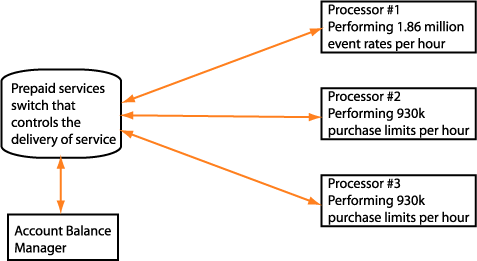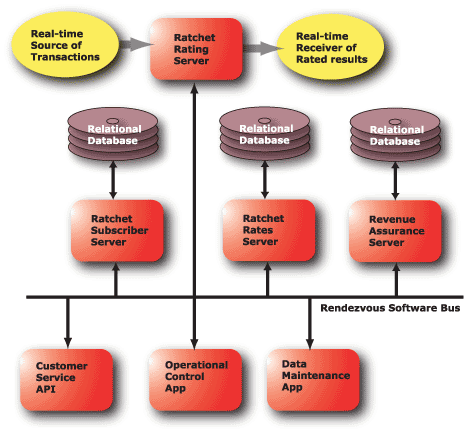 Ratchet™
Rating System
Ratchet™
Rating System
Rate more than one million prepaid calls and data transactions per hour with less than $4,000 in equipment
Rating prepaid voice and data services requires that your rating system perform at speeds that support the control of calls in real-time. When the response of your rating software is too slow, you make customers wait on the phone and increase your minutes of usage without increasing your revenue.
How Prepaid Is Done
Each service event (voice or data) involves a determination of the maximum amount of the service to provide. This maximum is the amount of services that can be consumed for the current account balance. This is the "Purchase Limit" function.
After a service is provided, the cost of the actual service is calculated and subtracted from the current account balance. We call this the "Event Rate" function.
To process more than one million services per hour, you must process one million Purchase Limits and one million Event Rates. Actually, to earn the revenue from one million transactions, you do more than one million Purchase Limits. Because you do the Purchase Limit before the call starts, you do them for all the calls where the called party doesn't answer the phone.
The following diagram shows the flows of functions that must be performed to do prepaid voice and data services.

Figure 1. This panel shows the flow of processing involved in supporting prepaid voice and data services.
Performance Information
The Ratchet Rating System scales across different processors at different speeds and can run on many different types of processors. Using a 1.2 GHz Pentium IV processor, you can process transactions at the following rates per hour. Each type of transaction is measured independently.
|
Type
of Function
|
Rate
per Processor
|
|
Purchase
Limits
|
930,000
per hour
|
|
Event
Rates
|
1,860,000
per hour
|
When these two functions are mixed together on one processor, the total number of calls that this processor can handle is less than 620,000 per hour. If you use three of these processors, you will exceed our goal of 1,000,000 transactions per hour. You will process more than 1,800,000 transactions per hour.
The performance measurements above were made with a message based configuration. All the transactions were individually sent via Ethernet to the processors from the switch and returned as individual messages. The transactions were not batched. They were real-time processed.
The following diagram shows three processors providing the needed number of functions to handle more than one million service transactions per hour.

Figure 2. This shows the distribution of transactions across three processors to meet our performance goal.
The transactions to process our call may be distributed across multiple processors because there is no order dependence on the correct processing of the transactions. You can do the Purchase Limit for a call on processor #2 and the Event Rate for the call on processor #1.
In situations where you permit the same calling card or account to support simultaneous transactions, portions of the call must be rated and the purchase limit recalculated during the service delivery. This increases the number of transactions that rating software must process for the same number of charged-for calls.
You can distribute
your transactions across the processors with the switch software or with
a small computer placed in front of the rating array. A simple solution
for load-balancing is to send all the Event Rate transactions to one processor
and then spread the Purchase Limit ransactions based on the odd-even ending
digit on the card number to two other processors.
Hardware To Do Your Rating
There are two simple alternatives to providing the hardware for this solution. The ones listed are given as examples. Other hardware can work.
| Type of Hardware | Configuration | Cost
(as of 7 Dec 2001) |
| Sun Netra X1 | 500 MHz processor; 256 MB Ram, 40 GB disk, 19 inch rack mountable; additional models available that run on DC power. (no monitor) | $995 each |
| Dell Dimension 4550 | 2.0 GHz Pentium 4 processor, 256 MB Ram, 60GB disk, minitower case (no monitor) | $749 each |
Conclusion
You can lower your costs of doing business and make it easy to scale up to larger amounts of revenue by using the Ratchet™ Rating distributed real-time application.
Service Level LLC provides the Ratchet™ Rating system to support the needs of both the new Internet oriented marketplace as well as the traditional circuit switched marketplace. We realize that the traditional services still provide the largest part of the world's communications requirements.

Figure 3. The components of the Ratchet™ Rating System
You can learn more about the Ratchet Rating solution at http://www.servicelevel.net/. The product and its implementation support team make a success of your implementation. You can contact our representatives at sales@www.servicelevel.net
Service Level LLC
7006 Suncrest Drive
Saline, MI 48176
+1 734-827-2000 (voice)
+1 734-827-2200 (fax)
Time Zone: same as New York City

